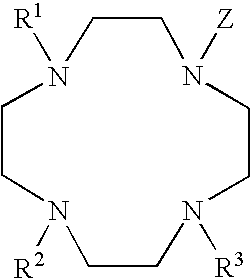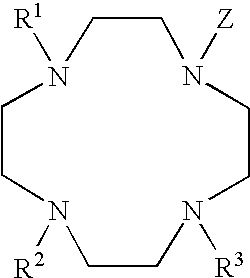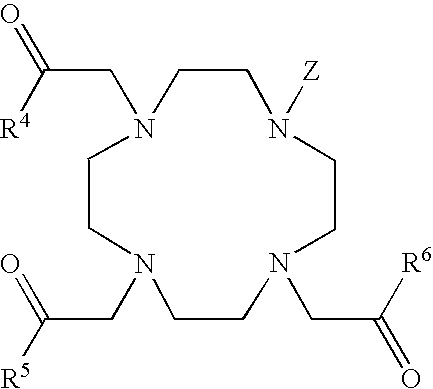Luminescent lanthanide complexes
a technology of lanthanide complexes and lanthanide, which is applied in the field of lanthanide chelates, can solve the problem that the method of lanthanide may be very selective, and achieve the effect of improving the lanthanide chelation efficiency and lanthanide synthesis efficiency
- Summary
- Abstract
- Description
- Claims
- Application Information
AI Technical Summary
Problems solved by technology
Method used
Image
Examples
example 1
[0057] The structures of two examples of lanthanide complexes, DP-1 and DP-2, are provided below. These complexes include a terbium ion, a heteropolycyclic sensitizer moiety, and are efficiently excited by light having a wavelength of about 320 to about 390 nm.
[0058] Analogs of the DP-1 and DP-2 complexes may be prepared using other lanthanides, for example Eu, Dy, and Sm, among others. The DP-1 and DP-2 complexes are generally useful as luminescent labels, and particularly useful when used as reporter molecules in experiments based on Time-Resolved Fluorescence Resonance Energy Transfer (TR-FRET).
example 2
[0059] As discussed above, selected lanthanide complexes may be prepared that include reactive functional groups. The presence of a reactive group (RX) permits the covalent attachment of substances having desired biochemical properties to form conjugates. In one aspect, the conjugates substance may be a peptides or other organic ligand that is itself substituted by one or more phosphate groups. For example, selected complexes derived from DP-1 are provided below:
[0060] In compound (1) above, n=0 to about 5; X═O, NH, or S; Y═O, S, or Se. The covalent linkage (i.e., —(CH2)n—COOH) can be attached to the complex at the 3-through 8-position of the sensitizer moiety. The heteroatom Y on the sensitizer may be oxygen, sulfur, or selenium. Selected specific examples of reactive group-substituted sensitizer groups are shown in structures (1a) and (1b), specifically where the sensitizer is derivatized at the 3-position (1a), or at the 6-position (1b).
[0061] A carboxyl group may be attached ...
example 3
[0062] In structure (2) below, the sensitizer moiety has been derivatized with an isothiocyanate group that can then react with an amine to form a covalent thiourea linkage.
[0063] In compound (2) above, Y can be O or S; Z=none or an alkylphenyl linker. The covalent linkage (i.e., -Z-NH—) can be at the 3-through 8-position of the aromatic sensitizer. The R group may be a peptide containing one or more amino acid residues, including for example phosphoserine, phosphothreonine or phosphotyrosine. More particularly, the R group can be phosphoPKAtide. Alternatively, R can be any organic compound that includes one or more phosphate groups, including but not limited to alkylphosphate, alkyldiphosphate or alkyltriphosphate, or aryl moieties containing one or more phosphate groups.
PUM
| Property | Measurement | Unit |
|---|---|---|
| atomic numbers | aaaaa | aaaaa |
| atomic numbers | aaaaa | aaaaa |
| volumes | aaaaa | aaaaa |
Abstract
Description
Claims
Application Information
 Login to View More
Login to View More - R&D
- Intellectual Property
- Life Sciences
- Materials
- Tech Scout
- Unparalleled Data Quality
- Higher Quality Content
- 60% Fewer Hallucinations
Browse by: Latest US Patents, China's latest patents, Technical Efficacy Thesaurus, Application Domain, Technology Topic, Popular Technical Reports.
© 2025 PatSnap. All rights reserved.Legal|Privacy policy|Modern Slavery Act Transparency Statement|Sitemap|About US| Contact US: help@patsnap.com



